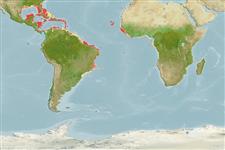Preferred temperature (Ref.
123201): 24.9 - 28, mean 27.1 °C (based on 268 cells).
Phylogenetic diversity index (Ref.
82804): PD
50 = 0.5002 [Uniqueness, from 0.5 = low to 2.0 = high].
Bayesian length-weight: a=0.02089 (0.01295 - 0.03371), b=2.94 (2.80 - 3.08), in cm total length, based on LWR estimates for this species & (Sub)family-body (Ref.
93245).
Nivel trófico (Ref.
69278): 3.1 ±0.1 se; based on diet studies.
Resiliencia (Ref.
120179): Medio, población duplicada en un tiempo mínimo de 1.4-4.4 años (Preliminary K or Fecundity.).
Fishing Vulnerability (Ref.
59153): Moderate vulnerability (36 of 100).
Nutrients (Ref.
124155): Calcium = 22.3 [6.6, 67.0] mg/100g; Iron = 0.715 [0.250, 1.955] mg/100g; Protein = 18.2 [16.0, 20.3] %; Omega3 = 0.0721 [, ] g/100g; Selenium = 47.6 [18.4, 133.5] μg/100g; VitaminA = 49.5 [13.6, 175.9] μg/100g; Zinc = 1.55 [0.70, 2.75] mg/100g (wet weight);
